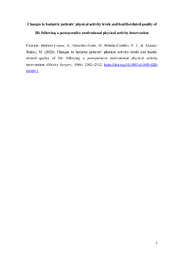Please use this identifier to cite or link to this item:
https://hdl.handle.net/11000/30159Full metadata record
| DC Field | Value | Language |
|---|---|---|
| dc.contributor.author | Jiménez-Loaisa, Alejandro | - |
| dc.contributor.author | González-Cutre, David | - |
| dc.contributor.author | Beltrán-Carrillo, Vicente J. | - |
| dc.contributor.author | Alcaraz-Ibáñez, Manuel | - |
| dc.contributor.other | Departamentos de la UMH::Ciencias del Deporte | es_ES |
| dc.date.accessioned | 2023-11-15T11:35:10Z | - |
| dc.date.available | 2023-11-15T11:35:10Z | - |
| dc.date.created | 2020-03 | - |
| dc.identifier.citation | Obesity Surgery, 30(6) | es_ES |
| dc.identifier.issn | 1708-0428 | - |
| dc.identifier.issn | 0960-8923 | - |
| dc.identifier.uri | https://hdl.handle.net/11000/30159 | - |
| dc.description.abstract | Purpose: Self-determination theory (SDT) has been widely used as a useful motivational framework for improving long-term adherence to physical activity (PA) and health-related quality of life (HRQoL). The aim of this study was to examine the effects of a 6-month motivational PA intervention (MPAI) on bariatric patients’ PA levels and HRQoL from pre-surgery to the end of the MPAI (7 months post-surgery). Additionally, a re-test was performed 13 months post-surgery. Methods: 40 participants undergoing sleeve gastrectomy were assigned to a 6-month MPAI or to a control group. The MPAI was based on techniques and messages from SDT. At baseline and post-intervention measures, both groups wore accelerometers for one week and completed the SF-36 questionnaire. Results: 32 participants (78.1% female) completed all measures and were included in the final analyses. PA levels did not significantly differ between groups as a consequence of the intervention. Clinically significant differences (d ≥ 0.5) favoring the MPAI group were found for SF-36 domains of bodily pain (at pre-surgery, increasing at 7- and 13-months post-surgery), general health and vitality (7 months post-surgery), and physical functioning and the physical component score (both 7- and 13-months post-surgery). Social functioning also showed clinically significant differences favoring the MPAI group at pre-surgery, increasing at 7 months post-surgery. These differences disappeared at 13 months post-surgery. Conclusions: SDT-based PA interventions could enhance several dimensions of bariatric patients’ HRQoL after surgery. Further research is needed to understand what motivational processes are key aspects to promote PA participation in these patients. | es_ES |
| dc.format | application/pdf | es_ES |
| dc.format.extent | 34 | es_ES |
| dc.language.iso | eng | es_ES |
| dc.rights | info:eu-repo/semantics/openAccess | es_ES |
| dc.rights.uri | http://creativecommons.org/licenses/by-nc-nd/4.0/ | * |
| dc.subject | Self-determination theory | es_ES |
| dc.subject | Sleeve gastrectomy | es_ES |
| dc.subject | Exercise | es_ES |
| dc.subject | SF-36 questionnaire | es_ES |
| dc.subject | Accelerometry | es_ES |
| dc.subject.other | CDU::7 -Deportes | es_ES |
| dc.title | Changes in bariatric patients’ physical activity levels and health-related quality of life following a postoperative motivational physical activity intervention | es_ES |
| dc.type | info:eu-repo/semantics/article | es_ES |
| dc.relation.publisherversion | https://doi.org/10.1007/s11695-020-04489-1 | es_ES |

View/Open:
Changes in bariatric patients’ physical activity levels (1).pdf
491,79 kB
Adobe PDF
Share:
.png)
